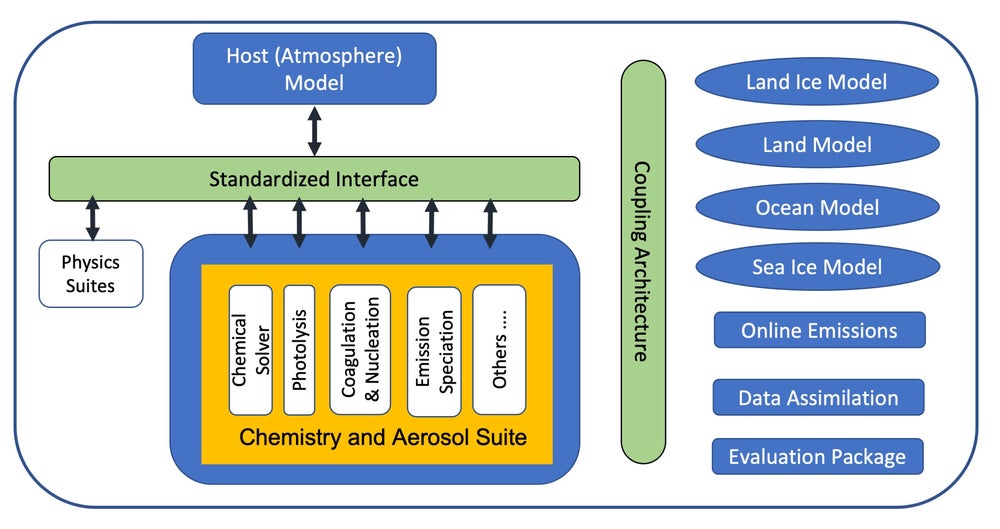MUSICA Background
1. What is MUSICA?
MUSICA is the next generation community infrastructure for studying atmospheric chemistry across all scales in a unified and modular approach. It is being developed by the community for the community with NCAR/ACOM as the “MUSICA Hub”. MUSICA will allow for simulations of large-scale phenomena while still resolving chemistry at exposure relevant down to turbulence resolved scales. The infrastructure will enable to address frontier science questions related to the interactions between atmospheric chemistry and weather and evironment while at the same time accounting for feedbacks between all components of the Earth System. MUSICA is envisioned to become a central tool not only for research but also for operational applications.
2. Why do we need MUSICA?
Empirical and modeling studies have provided strong evidence of dynamical and chemical coupling across the range of spatial and temporal scales inherent in the Earth System. Current models, however, are inadequate in accounting for the two-way coupling of the range of relevant scales from street-level to regional to global and from the surface up to the mesosphere. Limited to just a few days, current accurate air quality forecasts from regional models are not long enough for decision makers to take actions that could limit the negative health impacts of polluted air. Similarly, current Earth system estimates of air quality are hampered by the coarse resolution of chemical Earth system models or the initial and boundary problem posed to limited area regional chemistry Earth system models. Extending forecasts to 1-2 weeks, sub-seasonal to seasonal (S2S), and decadal timescales, along with reliable quantification of their uncertainties, requires bridging the gap between our current regional chemical weather models and our global chemical Earth system models.
3. What new Science will MUSICA enable?
The unification of the range of scales as realized in MUSICA accompanied by coupling of the atmosphere, land and ocean is crucial for the advancement of atmospheric composition predictability. MUSICA’s modular structure with a common interface and ease in directly inter-comparing individual modules in a unified framework will open the way to quantifying uncertainties of individual processes, e.g. assessing the influence of different aerosol schemes on radiative forcing.
MUSICA will significantly enhance current modeling capabilities and scientific applications such as assessing the contribution of transported pollution to local air quality and of local air quality on larger-scale regional and global composition by enabling globally consistent dynamics, physics and chemistry with high resolution in key regions; extending accurate high resolution local air quality forecasts to weeks to subseasonal and seasonal scales by accounting for teleconnections to large-scale atmospheric phenomena (e.g., ENSO and the Madden-Julian Oscillation); simulating the transport of pollutants from the surface to the upper atmosphere by the Asian Monsoon and its impacts on the global Earth system; or supporting the assessment and research for geostationary satellite constellations
4. What is the design behind MUSICA?
The specific goal of MUSICA is to produce a new model independent infrastructure, which will enable chemistry and aerosols to be simulated at a large number of different resolutions in a single, coherent fashion. At first, MUSICA will be configured within the NCAR Community Earth system Model (CESM®) and through this enables full feedbacks between the atmosphere, ocean and land. The infrastructure will unify the different chemical transport models including CAM-Chem, WACCM and WRF-Chem, NCAR LES with chemistry and a box model in a single modular framework. The model infrastructure will be open source, flexible and computationally efficient in order to facilitate community co-development and use for scientific and operational purposes.
At the heart of MUSICA is the standalone Model Independent Chemistry Model (MICM) that satisfies the requirements of the Common Community Physics Package (CCPP) and that can be connected to any CCPP compliant atmosphere model. MUSICA and MICM will have a flexible design to handle a variety of gas phase and aerosol schemes and associated chemical modules such as deposition or photolysis. Closely tied to the development of MICM and MUSICA is the development of tools for processing input data (e.g. emissions) on flexible grids, a common model evaluation framework and data assimilation capabilities.

5. Who are the MUSICA Community and Stakeholders?
MUSICA and MICM are being developed through joint initiatives of NCAR with the university community in support of the NSF/AGS atmospheric chemistry program and through the development of several strategic partnerships with prominent research groups and organizations in the USA and elsewhere in the world. The development of MUSICA will be guided by a Steering Group with committed representatives of the broad research community and by Working groups which are each co-lead by a representative from each within and outside NCAR.
The new capabilities represented by MUSICA will deepen existing and establish new working relations with academic and economic stakeholders. MUSICA will serve the needs of urban planners, environmental managers, city officials or air quality managers and contribute to the development of reduction policies or better warning systems for high pollution episodes.
6. What is the roadmap for MUSICA?
Within the next years, MUSICA will gradually replace the current suite of models supported by NCAR. The transition phase will be dictated by the progress of MUSICA providing at a minimum the capabilities of the current models. The transition will be accompanied by educational activities including user guides and in-person and online tutorials.